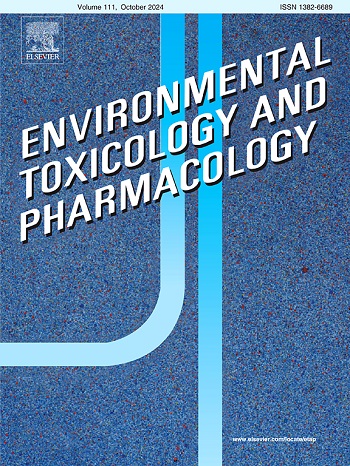Enhancement of detoxification of xenobiotic aromatic amine dyes by N-acetyltransferase 1 (NAT1) enzyme on human keratinocytes cells through structural modification
IF 4.2
3区 环境科学与生态学
Q2 ENVIRONMENTAL SCIENCES
引用次数: 0
Abstract
The metabolic conversion of aromatic amines to N-acetylated forms in skin and keratinocytes depends on N-acetyltransferase-1 (NAT1). Common hair color ingredient such as para-phenylenediamine (PPD) causes allergic contact dermatitis. We explored how different electronic substituents on PPD aided NAT1 enzyme biotransform oxidative arylamine (AA) compounds G1-G13 by N-acetylation, NAT-1 activity assays, metabolism, and in vitro clearance investigations in human keratinocytes, while identifying NAT-1 protein levels by Western blot and qRT-PCR. Electron-donating groups (EDG) compounds G2,G3,and G8, N-acetylate at a higher rate (58–62 nmol/mg/min), increase NAT1 activity by 20–25 %, and showed 3.4–3.8 times faster elimination and clearance rates than electron withdrawing groups (EWG) compounds G6 and G11. We found that chemicals substituted with EDG at ortho position increase aromatic system electron density, improving N-acetylation and detoxification on HaCaT cells. Our research facilitates the effective identification of aromatic amine hair dyes characterized by rapid metabolism, detoxification, and environmental safety.
N-acetyltransferase 1(NAT1)酶通过结构修饰增强人类角朊细胞对异生物芳香胺染料的解毒作用。
芳香胺在皮肤和角质形成细胞中向n -乙酰化形式的代谢转化依赖于n -乙酰转移酶-1 (NAT1)。常见的染发成分如对苯二胺(PPD)会引起过敏性接触性皮炎。我们通过n -乙酰化、NAT-1活性测定、代谢和体外清除研究,探讨了PPD上不同的电子取代基如何帮助NAT1酶在人角质形成细胞中生物转化氧化芳胺(AA)化合物G1-G13,同时通过Western blot和qRT-PCR鉴定了NAT1蛋白水平。给电子基团(EDG)化合物G2、G3和G8的n-乙酰化速率更高(58 ~ 62 nmol/mg/min), NAT1活性提高20 ~ 25%,清除和清除率比吸电子基团(EWG)化合物G6和G11快3.4 ~ 3.8倍。我们发现在邻位取代EDG的化学物质增加了芳香系统的电子密度,改善了HaCaT细胞的n -乙酰化和解毒作用。本研究有助于对代谢快、解毒快、环保安全的芳香胺类染发剂进行有效鉴定。
本文章由计算机程序翻译,如有差异,请以英文原文为准。
求助全文
约1分钟内获得全文
求助全文
来源期刊
CiteScore
7.00
自引率
4.70%
发文量
185
审稿时长
34 days
期刊介绍:
Environmental Toxicology and Pharmacology publishes the results of studies concerning toxic and pharmacological effects of (human and veterinary) drugs and of environmental contaminants in animals and man.
Areas of special interest are: molecular mechanisms of toxicity, biotransformation and toxicokinetics (including toxicokinetic modelling), molecular, biochemical and physiological mechanisms explaining differences in sensitivity between species and individuals, the characterisation of pathophysiological models and mechanisms involved in the development of effects and the identification of biological markers that can be used to study exposure and effects in man and animals.
In addition to full length papers, short communications, full-length reviews and mini-reviews, Environmental Toxicology and Pharmacology will publish in depth assessments of special problem areas. The latter publications may exceed the length of a full length paper three to fourfold. A basic requirement is that the assessments are made under the auspices of international groups of leading experts in the fields concerned. The information examined may either consist of data that were already published, or of new data that were obtained within the framework of collaborative research programmes. Provision is also made for the acceptance of minireviews on (classes of) compounds, toxicities or mechanisms, debating recent advances in rapidly developing fields that fall within the scope of the journal.

 求助内容:
求助内容: 应助结果提醒方式:
应助结果提醒方式:


